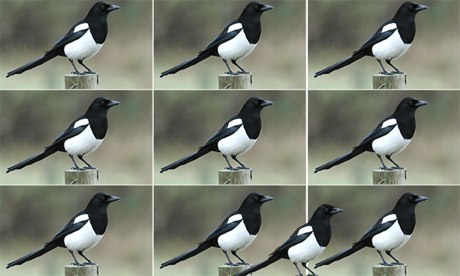
One for sorrow
Two for joy
Three for a wedding
Four for a death
Five for silver
Six for gold
Seven for a secret not to be told
Eight for Heaven
Nine for Hell
And ten for the devil coming for your soul
It is tempting to see the counting of magpies, and the chanting of verses about what the number of these distinctive black and white birds might mean, as a tenuous but still active strand of traditional lore that links us directly to the ancient art of divination by watching the flight of birds (augury). We know that priests throughout the ancient world attempted to read the future by watching the passage of birds pass some sacred feature, such as a temple sanctuary, a headland or the gates of a city. The direction of their flight, their species, their number, the month, the hour and the shape of the flocks must all have had a significance that is now lost to us. One has only to think of the shapes formed by starlings at dusk, the vast squadrons of migrating geese or gulls returning every night to the sea, to touch upon the complexities of this art, let alone what the chance sighting of an erratic might configure...
The counting of magpies encountered on an English pathway drops us into a more homely version of this lost science, concerned with the fate of an immediate family. As with any ancient oral tradition, there is a considerable variety after the first two lines. The most popular version in use today stops at seven. It is also worth noting that the magpie is a meat-eating corvid, and that the British have always tended to weave gloomy references around magpies and their bigger cousins, such as crows and most especially the raven. All these birds would have been seen to feed off the dead of the battlefield, or those left swinging on the gallows, exhibited on the gibbet or impaled on a pike.
Tomorrow: Eleven footballers
• Taken from Rogerson's Book of Numbers by Barnaby Rogerson (Profile).
Reading on mobile? Listen to the pop song Magpie

